Dear Reader,
You might be surprised to learn that a disorient1 like me has no problem at all in differentiating left from right. That’s something that’s ingrained: it’s built-in, pre-programmed, in the way that north, south, east and west are not. I don’t have to even think about which is left and which is right: it’s automatic. I know my port from my starboard, my nearside from my offside, which side I need to mount a horse and which hand I would need for wielding a sword in hypothetical combat. And I’ve always known that this phrase, offered up by a teacher in my very early school days, didn’t apply to me:
The right hand is the one that you write with, and the left hand is the one that’s left.
That’s not to say that I have no problem with left and right, because I do. As a left-hander I struggle with the fact that the world seems to be set up by default for the right-handed.
I get it, I do. Left-handed people are in the minority by quite a long way. In this story BBC Newsround reported that between ten and twelve percent of the world’s population is left-handed. That’s a huge statistic, in that it’s really not huge. In terms of proportion, I mean. I almost feel left out! More so, in fact, because this article reports that while across the world 12% of men are left-handed, only 8% of women are.
Reader, if you’re right-handed, take a moment to consider the things that you take for granted for their accessibility and ease of use. And if you’re left-handed, consider the things that inconvenience you in their inaccessibility. I wonder how much those two lists overlap? I’d venture to say it’s a lot.
For instance, on which side of the front of your suit trousers is that convenient little pocket for your train ticket? And more importantly, where’s the slot for that ticket in that gleaming bank of ticket barriers at the railway station?
Both are on the right. Of course they are.
Left-handed and lost
The first time – of many – that I got lost in London I had been left behind at the Tube station one evening on a school sixth-form2 trip to see a play at the National Theatre. We’d finally been deemed mature old enough to make the trip unaccompanied by staff, so nobody had felt obliged to notice that I was missing.
At the Tube station I’d posted my Travelcard into the slot on my left as I made to pass through the barrier in front of me. The barrier didn’t open. Or at least that one didn’t: I’d open sesamed the one on my left simply because that was my dominant side, and putting my ticket in there had felt natural. An amused station staff member let me through, giggling ‘ticket on the right’, and once I’d finally caught up with my friends at the theatre I was in such a state that it was all I could to not weep my way through the first act.
(Reader, if you’d like to know the plot of ‘The School for Scandal’ by Richard Brinsley Sheridan, please don’t ask me. My mind was elsewhere during the entire performance: I’d left it – alongside every scrap of confidence I’d set out with that evening – at the Green Park ticket barrier.)
Remember that ticket pocket? The one for right-handed people? Clothing often has a right-handed bias. The zip-up jacket I wear on my chillier walks has what should be a convenient sleeve pocket, but it’s located inconveniently on its left sleeve, where my left hand can’t reach it. My walking trousers and shorts – pretty much the only things I wear on the bottom half these days since developing my passion for the great outdoors – each have a back pocket.
A back pocket. One. Singular.
And it’s on the right.
Many products that have been thoughtfully designed for the convenience of the general population can be rather less convenient for the likes of me. Regard, if you will, this early version of a clever all-in-one spoon, knife and fork:
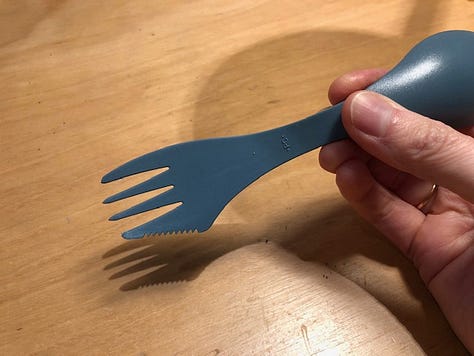
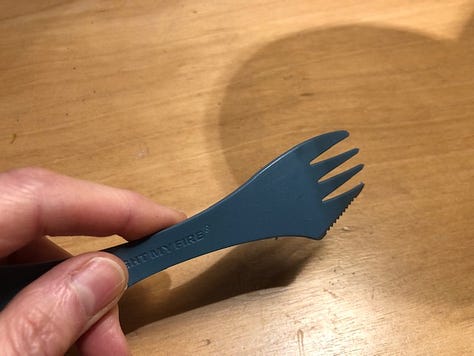
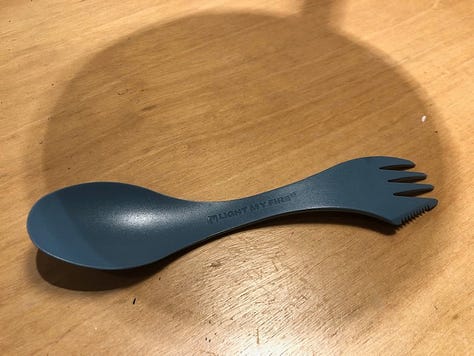
This gadget is easy to cut with if you’re wielding it in your right hand, but because of its ergonomic curve the fork is actually pointing backwards if you’re trying to use the serrated edge left-handed. There are various brands and models of tools like this now – including left-handed ones – and there’s at least one out there that isn’t ‘handed’ at all, its serrated edge being located at the end of the spoon part.
Mugs, particularly ones with pithy slogans or commercial advertising, often have their designs printed on one side – the side easily displayed by the right-handed drinker.
And what about pens and pencils? This pencil belongs to a ‘SUPER READER’. Well, you’re a super reader if you’re using the pencil right-handed. But am I, a left-hander, a super writer with it? Clearly not: the slogan’s upside down. Not so super.
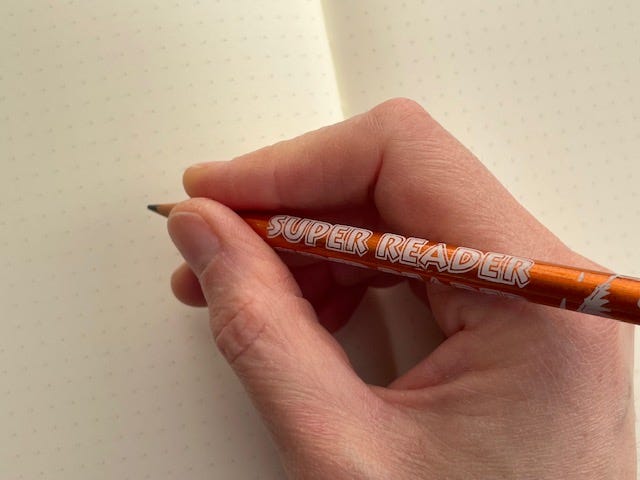
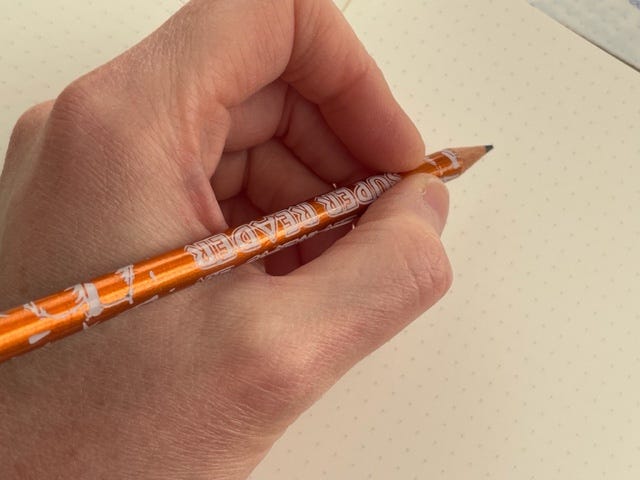
I treasure the pencil below, though. It was a free gift that had come with an Etsy purchase, and the seller had pyrographed her company name on the pencil from left to right. (And she didn’t even know that I’m left-handed.)
Ha! I win!
Mugs and writing implements aside – for their handedness is for reasons of prettiness rather than practicality – there is one product with which I really struggle as a left-hander.
Reader, I’m rubbish with scissors – and that statement cuts both ways (sorry!). I find both left-handed scissors and their standard right-handed counterparts difficult. They’re uncomfortable to use, and even I laugh at myself when I’m trying to cut a piece of paper.
I’ve tried left-handed scissors – Father Christmas left a pair in my stocking one year, blades duly taped by his elves as a necessary nod to safety – but I couldn’t use them. Although they were far more comfortable to hold and to handle than a standard pair, I couldn’t make them actually cut, which I’m sure you’ll agree is a pretty basic requirement.
Over the years I’d been persevering, albeit uncomfortably, with operating standard scissors with my left hand in such a way as to make those awkward blades engage with what I’d be trying to cut, which I would manage by pulling back as I closed them in order to make the blades better grip the paper. Yet even though I now had a pair of left-handed scissors in my armoury I just couldn’t reverse-engineer all that reprogramming. Trying to cut using my tried-and-tested technique but with a left-handed pair was a total non-starter, to put it bluntly. 😉
The wrong way to mark work that is right ✓
I’d once toyed with the idea of becoming a school teacher3, and I’m amused, with hindsight, to think about how very difficult I would have found it to mark pupils’ work.
Because Reader, I cannot tick. Drawing a tick is very much a right-handed movement, requiring the pulling rather than the pushing of the pen. My ticks are half-ticks which head upwards and left: the handwritten equivalent of a backslash, the result of a pull, not a push.
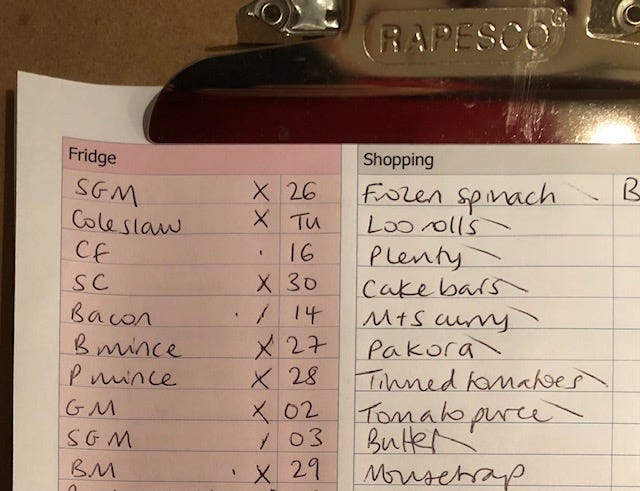
Yet my left-handedness is very compatible with my bullet journalling habit! Task bullets, migration and scheduling arrows, note lines, event circles and signifiers all appear on the left-hand side of the page. Earlier I wrote about things people take for granted in terms of their handedness, and this is a rare thing that I take for granted. In this case, the right way round is my way round!
I win again!
Left-handed learning
I love to learn, and over the years I’ve taken workshops in a succession of creative pursuits. Where handedness comes into play – as it so often does with crafts – I’ve become used to automatically interpreting instructions and demonstrations for myself so that I can do them ‘my’ way round. This has never been a problem: I have grown to expect that I need to do this, and it’s become second nature.
(Disclaimer: I failed at crochet demonstrated by a right-handed textile artist. I’m grateful to Bella Coco on YouTube for her amazing left-handed crocheting videos.)
When I started teaching my own craft of melting glass in the flame to create lampwork beads I would ask my students in advance which their dominant hand was so that I could set their workbenches up in the appropriate orientation. My first couple of demos to a class would be right-handed, and then with a flourish I’d grab my glass rod with my left hand to make a bead that way round.
‘If you find it more comfortable to do it this way, please go ahead!’ I’d say with a wink. ‘Because all the best people are left-handed4!’
Reader, this would always be an excellent ice-breaker, but more than that, it brought home to my students, regardless of their handedness, that there might be more than one way to accomplish a task.
For my wirework jewellery making classes I made sure to flip the pictures and swap the words ‘left’ and ‘right’ in the instructions on my handouts. I’d demonstrate both ways round – always with an apology for the probably less-than-perfect finished article made with my wrong right hand.
And look, there it is. The ‘wrong’ versus ‘right’ side of things.
If it’s not right, is it wrong?
Well, is the opposite of ‘right’ wrong? In handedness terms, I mean. Well, I’m not sure it is exactly, but there’s certainly a historical stigma there.
I plucked the French word for left, gauche, out of the air, and flicked it screaming into the Google search bar.
Here’s what I found courtesy of Merriam Webster:
Although it doesn’t mean anything sinister, gauche is one of several words (including sinister) with ties to old suspicions and negative associations relating to the left side and use of the left hand. In French, gauche literally means “left,” and it has the extended meanings “awkward” and “clumsy.” These meanings may have come about because left-handed people could appear awkward trying to manage in a mostly right-handed world, or perhaps because right-handed people appear awkward when trying to use their left hand. Regardless, awkwardness is a likely culprit. Fittingly, awkward itself comes from the Middle English awke, meaning “turned the wrong way” or “left-handed.” On the other hand, adroit and dexterity have their roots in words meaning “right” or “on the right side.”
And not content with looking up just the definition, I also had a look at some synonyms for gauche:
Awkward, clumsy, maladroit, inept, gauche mean not marked by ease (as of performance, movement, or social conduct).
Awkward is widely applicable and may suggest unhandiness, inconvenience, lack of muscular control, embarrassment, or lack of tact.
- periods of awkward silenceClumsy implies stiffness and heaviness and so may connote inflexibility, unwieldiness, or lack of ordinary skill.
- a clumsy mechanicMaladroit suggests a tendency to create awkward situations.
- a maladroit politicianInept often implies complete failure or inadequacy.
- a hopelessly inept defense attorneyGauche implies the effects of shyness, inexperience, or ill breeding.
- felt gauche and unsophisticated at formal parties
Charming!
Latin for ‘right’ is dexter, which is the root of the word dextrous, with all its lovely connotations to skill, deftness and efficiency. And as Merriam Webster has just told us, sinister is altogether rather less positive.
We worked with a school group on a job at a Roman fort this year, and you might remember this post about it. To our delight, the children had arrived chanting ‘sinister, dexter, sinister, dexter’ as they marched onto the site, clearly already in the mindset of the Roman soldiers they were due to be trained up as.
‘Look!’ I nudged Jim. ‘Most of them have mixed up their left and right!’. Handedness often corresponds to footedness, and the majority of the children, despite knowing their chant would start with ‘sinister’, had set off right-foot forwards, because that was their starting foot by default. Programmed, you see. I enjoyed noticing the minority with their feet the correct way round.
‘Oh’, said right-handed Jim. ‘I hadn’t noticed’.
Left is for loser - or at least it is in my case
In our everyday activities we don’t generally have to think about our handedness: we favour our dominant side automatically. It’s instinctive.
It’s for that reason that I’ll never forget the first time my friends and I discovered that gesture for ‘LOSER’. Yup, that one.
But here’s what I looked like:
Yup. A loser.
We can, do, and sometimes shouldn’t all categorise ourselves and each other into any number of subsets, and those subsets can identify us as unique, or as parts – or not – of a community. Bias is everywhere, be it physical, cultural, racial, sexual, financial or any combination of those things and very many others. Reader, I identify as being part of the left-handed subset of the population. And yes, sometimes I’m even a loser – but I might just get around that next time by switching off my left-handed autopilot in time to make the right gesture.
I quietly enjoy my minority awkwardness. And whether or not it makes me awkward, clumsy, inept, in-bred, gauche or just plain sinister, left is still absolutely the right way round for me.
Love,
Rebecca
If you enjoyed this post, please let me know by clicking the heart. Thank you!
Thank you for reading! If you enjoy ‘Dear Reader, I’m lost’, please share and subscribe for free.
When I started writing about getting lost I couldn’t find an individual word already out there in the wild to describe myself. I stole a chunk of ‘disorientated’ to do the job, and I think it works.
Sixth form is the final two (non-compulsory) years of secondary school here in UK. Sixth-formers are 16-18 years old.
Although I didn’t end up teaching children, I am qualified to teach in the adult education sector.
Of course, many of the best people are left handed. Forgive me for cherry-picking my favourites, but here are some:
Bill Clinton and Barack Obama – former US presidents
Winston Churchill and David Cameron – former UK prime ministers
The Prince of Wales, and his great-grandmother, the Queen Mother – members of the British royal family
(George VI is reputed to have been left-handed, but he was made by his father, George V, to change to writing with his right hand. This is a scandal in itself, and I gather this is something that my father-in-law’s teachers tried to force him to do. He remained resolutely left-handed, but that experience at school had certainly left its mark.)
Leonardo da Vinci, Albert Einstein, Lewis Carroll, Joan of Arc, Bill Bryson, Paul McCartney, Marilyn Monroe and Tom Cruise were or are all left-handed, as are the fictional Bart Simpson and his real-life creator Matt Groening. So was Chewbacca the Wookie.
And although he doesn’t count amongst my favourites, Jack the Ripper is thought to have been left-handed. Those hunting the Victorian murderer were convinced of this from the evidence of the knife injuries he’d inflicted on his victims.




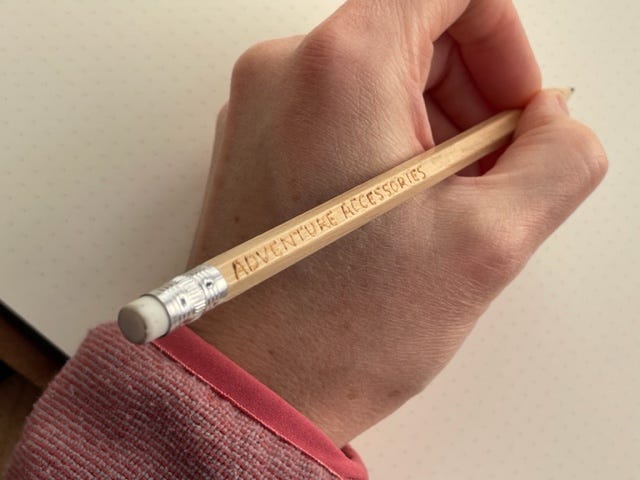

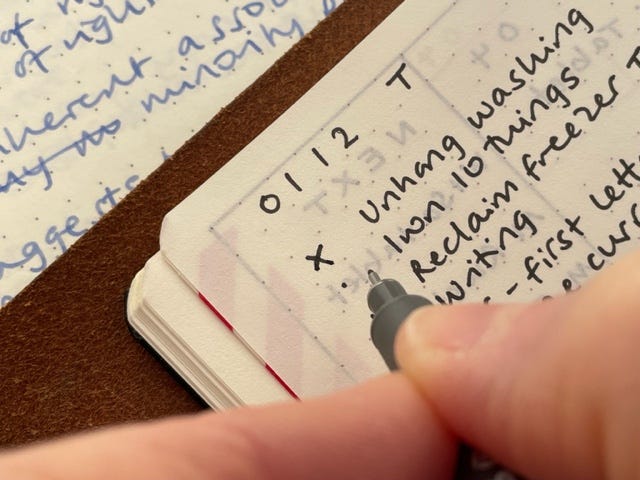
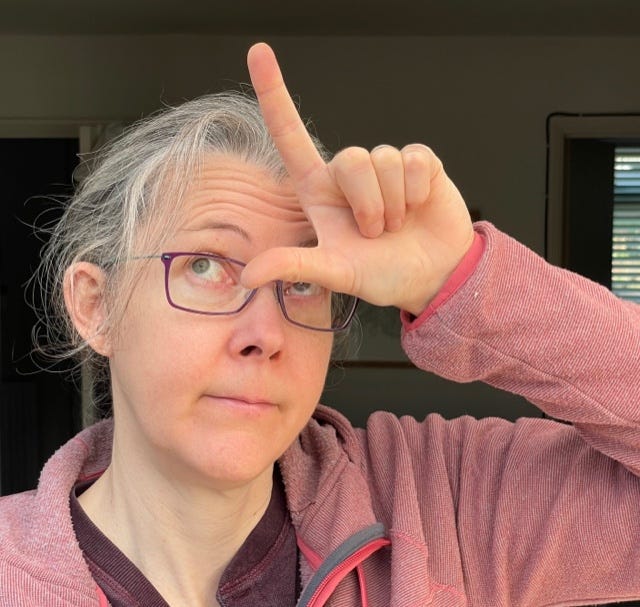
My dad is also a lefty, so I appreciate some of the difficulties you have to deal with on a daily basis. He's told stories about how the nuns in Catholic school used to force him to write with his right hand as a kid. It didn't take. And it seems that a lot of interesting figures in history have also been lefties, making me wonder if all of that adaptiveness and creative problem solving isn't a secret (sinister?) super power... :-)
You know, as an inveterate right-hander, this way of seeing the world just doesn’t speak to me. The whole “this doesn’t work for me” vibe just feels off. And THAT must be how you feel. I’m gonna have to think about that one a bit.